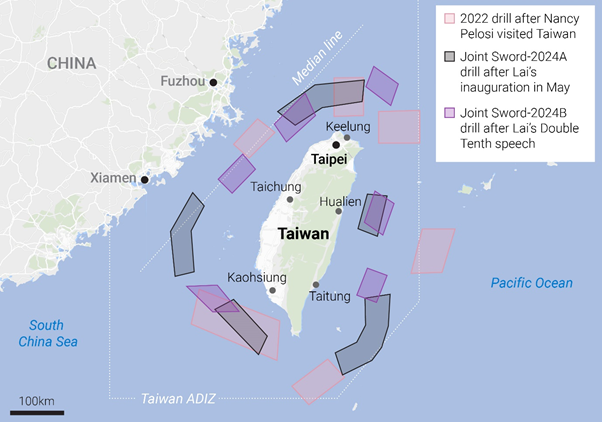
Indian Council of World Affairs
Sapru House, New DelhiCross-Strait Relations under Donald Trump 2.0
Abstract: With the coming of Donald Trump, the issue of US support for Taiwan has resurfaced in larger geopolitical discourses. The early signs of cross-strait relations suggest that in the Trump 2.0 era, the US will make more arms sales and be actively involved in the region. These developments will continue to cause uproar in the Indo-Pacific region.
One of the most complicated issues Donald Trump has inbred in his second term as the 47th US President is Taiwan and cross-strait relations. The US plays a crucial role in these relations. The paper reviews cross-strait relations and their development under Donald Trump in his second term as President.
An Overview of Recent Cross-Strait Relations
After the South China Sea issue, Taiwan Strait/cross-strait relations are the flashpoint in the Indo-Pacific region. Lai Ching-te became the President of Taiwan in May 2024, succeeding Tsai Ing-wen. Both the leaders were from the Democratic Progressive Party (DPP). For the first time in Taiwan, a political party has been elected three times. In his National Day speech, he reiterated China “has no right to represent Taiwan”.[i]
In response to the National Day speech, China conducted the “Joint Sword-2024B” exercise on 14 October 2024 in the Taiwan Strait, northern Taiwan, southern Taiwan, and east of the island. This was only the second fierce exercise after Nancy Pelosi’s visit in 2022. The People’s Liberation Army (PLA) held exercises to demonstrate its prowess and ability to coordinate maritime control with the China Coast Guard. With each of these exercises, China is trying to move progressively closer to Taiwan. The China Coast Guard vessels also activated their automatic identification system (AIS) tracking signals to intimidate Taiwan.[ii]

Source: South China Morning Post: https://www.scmp.com/news/china/military/article/3298305/pla-tracks-us-navy-ships-first-taiwan-strait-transit-trumps-return
The cross-strait relations have further deteriorated since the beginning of this year. On 1 January 2025, Xi Jinping, in his New Year speech, said that the Chinese on both sides of the Taiwan Strait belonged to one family, that no one could sever the bond of kinship between them, and that “no one can ever stop China’s reunification – a trend of the times”.[iii] China has also called Lai Ching-te a “destroyer of peace” in the Taiwan Strait following his recent remarks at a Lunar New Year event for the island’s business leaders.[iv] China is trying to intimidate and pressurise Taiwan in all possible ways. On the other hand, on 3 February 2025, President Lai Ching-te called for “dialogue instead of confrontation”. He opined that Taiwan and China need to talk to each other to achieve peace given the “multifold changes” in the international situation. Besides these developments with the coming of Donald Trump, cross-strait relations have further deteriorated.
Apart from the drills, China is also trying to cut Taiwan’s communication link with the rest of the world. On 3 January 2025, a Cameroon-flagged cargo vessel, “Shunxin-39”, damaged an undersea cable of Taiwan telecoms operator Chunghwa Telecom. China has a long history of sabotaging Taiwan.[v] A Chinese ship damaged an undersea communication cable off Taiwan’s coast.[vi] Closer to the Chinese lunar year, on 28 January 2025, 52 “suspicious” Chinese-owned ships flying flags of convenience were seen in the Taiwanese water. Taiwan has 14 international underwater cables and 10 domestic ones.[vii] This could be an attempt to seize Taiwan or blockade it by cutting Taiwan’s communication with the rest of the world.
Taiwan and Donald Trump
With Donald Trump’s re-election as the 47th President of the US, the issue of US-Taiwan has resurfaced. It may be recalled that during Donald Trump's first tenure, US-Taiwan relations reached a new level.
During his previous tenure, Trump signed many bills and acts in favour of Taiwan. On 16 March 2018, the Taiwan Travel Act,[viii] which encouraged visits between officials of the US and Taiwan at all levels, was signed. On 4 March 2020, the US House of Representatives passed the Taiwan Allies International Protection and Enhancement Initiative Act of 2019 (TAIPEI). On 11 May 2020, the US Senate passed legislation supporting Taiwan’s participation in the World Health Organisation (WHO). According to the bill, the US Secretary of State should work towards the re-entry of Taiwan into the WHO. [ix]
In his previous tenure, Donald Trump supplied arms to Taiwan. The first arms package sale worth $1.4 billion was done on 30 June 2017. The second sale package of $330 million was signed in October 2018. In July 2019, the US supplied M1A2T Abrams tanks, Stinger missiles, and related equipment to Taiwan. The US State Department had also approved the sale of three weapons systems to Taiwan, including sensors, missiles and artillery, worth $1.8 billion. It has also approved the sale of 100 Boeing-made Harpoon Coastal Defence Systems. In 2020, the Trump administration announced arms sales worth $5.1 billion to Taiwan.10 Overall, he had approved 18 arms sale deals to Taiwan.
In 2024, soon after Donald Trump’s victory, Lai Ching-te wrote a congratulatory message on X: “Sincere congratulations to President-elect @realDonaldTrump on your victory. I’m confident that the longstanding #Taiwan-#US partnership, built on shared values & interests, will continue to serve as a cornerstone for regional stability & lead to greater prosperity for us all”. The Taiwanese delegation also attended the swearing-in ceremony of Donald Trump at the Capitol Visitor Center/Emancipation Hall nonetheless, they did not attend the swearing-in ceremony in the Capitol Rotunda due to space limitations.[x]
In one of the meetings between Donald Trump and Akie Abe, he described Taiwan “as a major issue for world peace”.[xi] This indicates the orientation of the Trump administration towards Taiwan. As Trump takes over as President of the US for the second time, the continuation of US assistance to Taiwan and the impetus on arms sales have again come to the forefront.
On 21 December 2024, the US announced military assistance to Taiwan valued at $571.3 million. On the same day, the Department of Defence of the US announced that the State Department had approved $295 million worth of arms sales to the island.[xii] On 10 February 2025, Taiwan signed a $761 million procurement contract with the US for three Norwegian Advanced Surface-to-Air Missile Systems (NASAMS) to aid their air defence capabilities in the northern Taiwan region.[xiii] It may be noted that Donald Trump has selected people like Mike Waltz and Marco Rubio, who are hard-line on China, for his team. The US National Security Adviser Mike Waltz has expressed that he wants to speed up the delivery of weapons to Taiwan.[xiv]
China has always been critical of the US arms sales to Taiwan. China has protested against the arms assistance to Taiwan.[xv] A spokesperson for China’s Ministry of National Defence condemned the US arms sales to the Taiwan region, reiterating that the Taiwan question is the first red line that must not be crossed in China-US relations. The spokesperson of the Chinese Foreign Ministry said, that “to aid “Taiwan’s independence” by arming Taiwan is just like playing with fire and will get the US burned, and to use Taiwan’s question to contain China is doomed to fail.” [xvi]
As a protest to the US arms sales to Taiwan, China has targeted small mid-sized American drone manufacturers and service providers. It also sanctioned Raytheon's President and Vice President (a major US defence company) group. The Chinese Foreign Ministry spokesperson had alluded to the fact that the sanctions were a countermeasure for the “repeated announcement of arms sales to Taiwan”, which seriously violated the one-China policy. He said, “We urge the United States to clearly recognise the serious danger that separatist acts of Taiwan independence pose to peace and security across the Taiwan Strait … and to stop sending wrong signals to Taiwan separatist forces”.[xvii]
The US-China technology war is also affecting the development of the Taiwan Strait. Taiwan has the most valuable chip-producing company, Taiwan Semiconductor Manufacturing Company (TSMC). TSMC is a big ticket in the ongoing US-China war. TSMC produces an estimated 90 per cent of the world’s super-advanced semiconductor chips, with around 70 per cent manufactured in Taiwan. Donald Trump has threatened to impose tariffs on Taiwan’s semiconductor exports to encourage the reshoring of chip manufacturing.[xviii] It may be noted that China and Taiwan may face pressure from the new US administration.
As Donald Trump took charge of the office, the US started showing its presence in the region. On 10 February 2025, two American naval vessels, the US destroyer USS Ralph Johnson and the oceanographic survey ship USNS Bowditch transited the Taiwan Strait. The transit was the first by the US Navy since the swearing-in of Donald Trump. The information was not shared on the Indo-Pacific Command website. This is a departure from usual practice. To keep a watch, China’s People’s Liberation Army’s Eastern Theatre Command organised its sea and air forces to follow the entire movement of the US vessels. The unfolding of these developments is making the region volatile.
Recently, an updated factsheet by the Department of Bureau of East Asia and Pacific Affairs of the US Department of State has created an uproar in cross-strait relations. The previous version stated that the US opposes “any unilateral changes to the status quo from either side; we do not support Taiwan independence; and we expect cross-Strait differences to be resolved by peaceful means.”[xix] The updated paragraph now reads: “We oppose any unilateral changes to the status quo from either side. We expect cross-Strait differences to be resolved by peaceful means, free from coercion, in a manner acceptable to the people on both sides of the Strait”.[xx]
The Global Times published that the US government has long stated that it opposes any unilateral changes to the status quo from either side”. However, the actions of the “Taiwan independence” forces and the interventions imposed by many US policies and “bills” have all undermined the stability of the Taiwan Strait. This is rooted in the US’ attempt to utilise the “Taiwan independence” forces to bind the island to Washington’s geostrategic chariot.[xxi] The US calls it a routine update. The State Department spokesperson said: “As is routine, the fact sheet was updated to inform the general public about our unofficial relationship with Taiwan.” This is not the first time that the US has edited the statements. In May 2022, the lines on the US support were deleted/edited under the Biden administration. Later on, after protests from China, about a month later, it was reinstated.[xxii]
Conclusion
Taiwan is a vital factor in deciding the trajectory of US-China relations. According to the Centre for Preventative Action (CPA) annual report, “Intensified military and economic pressure by China toward Taiwan” is listed among other “top conflicts to watch in 2025” as a “Tier I (High Priority)” potential war.[xxiii]
Tensions in Cross-strait relations have reached a peak. The early signs of cross-strait relations suggest that in the Trump 2.0 era, the US will make more arms sales and frequent FONOPS in the region. Furthermore, Taiwan will continue to bear the brunt of its semiconductor facility. These developments will continue to cause a stir in cross-strait relations, and there may be escalations as well sometimes.
*****
*Dr. Teshu Singh, Research Fellow, Indian Council of World Affairs (ICWA)
Disclaimer: The views expressed are personal.
Endnotes
[i] Katrina Northrop, Taiwan’s President Lai says Beijing ‘has no right’ to represent Taipei, the Washington Post, 10 December 2024,
https://www.washingtonpost.com/world/2024/10/09/taiwan-china-national-day-lai-ching-te/, accessed on 10 January 2025.
[ii] Cheng-kun Ma, K. Tristan Tang, Joint Sword-2024B: Quarantining Key Ports and Seizing Comprehensive Superiority, Jamestown Foundation, 1 November 2024, https://jamestown.org/program/joint-sword-2024b-quarantining-key-ports-and-seizing-comprehensive-superiority/ accessed on 11 January 2025.
[iii] William Zheng, ‘Every bit of strength’: Taiwanese leader William Lai vows to boost island’s defences, South China Morning Post, 1 January 2025,
accessed on 15 January 2025.
[iv] Xinlu Liang, Beijing denounces Taiwanese leader William Lai as ‘destroyer of cross-strait peace’, South China Morning Post, 6 February 2025, https://www.scmp.com/news/china/politics/article/3297644/beijing-denounces-taiwanese-leader-william-lai-destroyer-cross-strait-peace?utm_medium=email&utm_source=cm&utm_campaign=enlz-china&utm_content=20250206&tpcc=enlz-china&UUID=11ce45a9-6e77-4f2f-87fa-00207e29660a&next_article_id=3297624&article_id_list=3297644,3297624,3297586,3297609,3297610,3297552,3297451,3297427&tc=5&CMCampaignID=82fd3c450a6f9f05bb78d355d94366b8 accessed on 20 February 2025.
[v] A Cameroon-flagged cargo vessel “Shunxin-39” was believed to have caused damage to an undersea cable of Taiwan telecoms operator Chunghwa Telecom, Taipei Times, 14 January 2025 https://www.taipeitimes.com/News/lang/archives/2025/01/14/2003830140
accessed on 16 January 2025.
[vi] Taiwan, China trade barbs over undersea cable damage, Reuters, 9 January 2025, https://www.reuters.com/world/asia-pacific/taiwan-china-trade-barbs-over-undersea-cable-damage-2025-01-09/ accessed on 17 January 2025.
[vii] AFP, Coast guard identifies 52 ‘suspicious’ Chinese ships, Taipei Times, 28 January 2025, https://www.taipeitimes.com/News/front/archives/2025/01/28/2003830950 accessed on 13 February 2025.
[viii] H.R.535 - Taiwan Travel Act, https://www.congress.gov/bill/115th-congress/house-bill/535 accessed on 10 January 2025.
[ix] Teshu Singh, US-Taiwan Relations under Joe Biden Administration, 31 December 2020, https://www.vifindia.org/article/2020/december/31/us-taiwan-relations-under-joe-biden-administration accessed on 12 February 2025.
[x] Shih Hsiu-chuan and Teng Pei-ju, Despite change in venue, Taiwan present at Trump's inauguration, Focus Taiwan, 21 January 2025, https://focustaiwan.tw/politics/202501210013 accessed on 12 February 2025.
[xi] Trump Discussed China-Taiwan Situation in Meeting with Abe’s Widow, Described Calling For Immediate End to War in Zelenskyy Talks, The Yomiuri Shimbun, 22 December 2024, https://japannews.yomiuri.co.jp/politics/politics-government/20241222-229166/ accessed on 12 February 2025.
[xii] Huaxia, Chinese defense ministry condemns U.S. arms sales to Taiwan, Xinhua, 24 December 2024, https://english.news.cn/20241223/b6005444b45d4432b2cfa15bec5db912/c.html accessed on 12 February 2025.
[xiii] Aaron Tu and Esme Yeh, Ministry signs US surface-to-air missile contract, Taipei Times , 11 November 2025, https://www.taipeitimes.com/News/front/archives/2025/02/11/2003831672
accessed on 12 February 2025.
[xiv] Michael Martina, Yimou Lee and Ben Blanchard, Taiwan considering multi-billion dollar arms purchase from US, sources say, Taipei Times, 18 February 2025, https://www.taipeitimes.com/News/taiwan/archives/2025/02/18/2003832086
accessed on 20 February 2025.
[xv] Wang Qingyun, US military aid, arms sales to Taiwan strongly deplored, firmly opposed, 22 December 2024, China Daily, https://www.chinadaily.com.cn/a/202412/22/WS6768144ea310f1265a1d4440.html
accessed on 12 February 2025.
[xvi] Zhao Yusha, Arming Taiwan to aid 'Taiwan independence' is like 'playing with fire and will get the US burned,' says Chinese FM, 21 December 2024, Global Times, https://www.globaltimes.cn/page/202412/1325517.shtml
accessed on 12 February 2025.
[xvii] Hayley Wong, Mainland China sanctions 13 US companies over weapons sales to Taiwan, 5 December 2024, South China Morning Post, https://www.scmp.com/news/china/military/article/3289488/mainland-china-sanctions-13-us-companies-over-weapons-sales-taiwan?utm_medium=email&utm_source=cm&utm_campaign=enlz-breaking_news&utm_content=20241205&UUID=11ce45a9-6e77-4f2f-87fa-00207e29660a&tc=1&CMCampaignID=b8a7c820dc3c885b14c636e5e2daafb3 accessed on 12 February 2025.
[xviii] Chang Hsin-yu, Lin Hung-han and Teng Pei-ju, Trump's threatened tariffs may affect industries in both U.S., Taiwan: Experts, Focus Taiwan, 13 February 2025, https://focustaiwan.tw/business/202502130013 accessed on 20 February 2025.
[xix] U.S. gov't fact sheet removes line on not supporting Taiwanese independence, Taiwan Focus, 16 February 2025, https://focustaiwan.tw/politics/202502160006 accessed on 20 February 2025.
[xx] US removes no independence statement, Taipei Times, 17 February 2025, https://www.taipeitimes.com/News/front/archives/2025/02/17/2003831999 accessed on 20 February 2025.
[xxi] The US is playing ‘Taiwan card’ again, but for how long?, Global Times 19 February 2025, https://www.globaltimes.cn/page/202502/1328681.shtml
accessed on 20 February 2025.
[xxii] U.S. gov't fact sheet removes line on not supporting Taiwanese independence, Taiwan Focus, 16 February 2025, https://focustaiwan.tw/politics/202502160006 accessed on 20 February 2025
[xxiii] Cross-strait war likelihood ‘moderate,’ survey shows, 9 January 2025, Taipei Times, https://www.taipeitimes.com/News/front/archives/2025/01/09/2003829892 accessed on18 February 2025.















